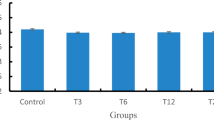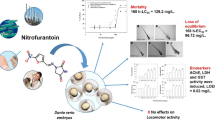Abstract
Antimicrobials, besides application in pharmaceuticals, are used as growth promoters in agriculture, especially for cattle, pigs, and poultry production, as well as, complement for fish in aquaculture. In addition to uses mentioned above, the improper disposal of these substances may cause problems in the aquatic environments such as bioaccumulation, bioconcentration and biomagnification. Thus, the aim of this study was to evaluate the bioconcentration and depuration of sulfadiazine using the teleost fish Danio rerio as test organism. During 20 days of exposal to 14C-sulfadiazine, a small amount of the antimicrobial concentration was observed on fish. Further, no depuration was noted during this period.
Similar content being viewed by others
References
Di Nica V, Menaballi L, Azimonti G, Finizio A (2015) RANKVET: a new ranking method for comparing and prioritizing the environmental risk of veterinary pharmaceuticals. Ecol Indic 52:270–276. https://doi.org/10.1016/j.ecolind.2014.12.021
Torres NH, Aguiar MM, Ferreira LFR (2015) Detection of hormones in surface and drinking water in Brazil by LC-ESI-MS/MS and ecotoxicological assessment with Daphnia magna. Environ Monit Assess 187:1–13. https://doi.org/10.1007/s10661-015-4626-z
Leal RMP, Alleoni LRF, Tornisielo VL, Regitano JB (2013) Sorption of fluoroquinolones and sulfonamides in 13 Brazilian soils. Chemosphere 92:979–985. https://doi.org/10.1016/j.chemosphere.2013.03.018
Padberg S (2015) Drugs during pregnancy and lactation (Third Edition), Treatment Options and Risk Assessment, pp 115–176. https://doi.org/10.1016/B978-0-12-408078-2.00007-X
Santos D, Luzio A, Coimbra AM (2017) Zebrafish sex differentiation and gonad development: a review on the impact of environmental factors. Aquat Toxicol 191:141–163. https://doi.org/10.1016/j.aquatox.2017.08.005
Fang H, Han Y, Yin Y (2014) Variations in dissipation rate, microbial function and antibiotic resistance due to repeated introductions of manure containing sulfadiazine and chlortetracycline to soil. Chemosphere 96:51–56. https://doi.org/10.1016/j.chemosphere.2013.07.016
Hamscher G, Pawelzick HT, Hoper H, Nau H (2005) Comportamento diferente de tetraciclinas e sulfonamidas em solos arenosos após a fertilização repetido com esterco líquido. Toxicol Ambient e Quim 24:861–868
Rivera-Utrilla J, Sánchez-Polo M, Ferro-García MÁ (2013) Pharmaceuticals as emerging contaminants and their removal from water: a review. Chemosphere. https://doi.org/10.1016/j.chemosphere.2013.07.059
Isidori M, Lavorgna M, Nardelli A (2005) Toxic and genotoxic evaluation of six antibiotics on non-target organisms. Sci Total Environ 346:87–98. https://doi.org/10.1016/j.scitotenv.2004.11.017
Reis Filho RW, Barreiro JC, Vieira EM, Cass QB (2007) Pharmaceutical drugs, WWTP, and hydric bodies. Ambient e Agua 2:55–61. https://doi.org/10.4136/ambi
Slana M, Dolenc MS (2013) Environmental risk assessment of antimicrobials applied in veterinary medicine-a field study and laboratory approach. Environ Toxicol Pharmacol 35:131–141. https://doi.org/10.1016/j.etap.2012.11.017
Besse JP, Garric J (2008) Human pharmaceuticals in surface waters. Implementation of a prioritization methodology and application to the French situation. Toxicol Lett 176:104–123. https://doi.org/10.1016/j.toxlet.2007.10.012
Santos LHM, Araújo AN, Fachini A (2010) Ecotoxicological aspects related to the presence of pharmaceuticals in the aquatic environment. J Hazard Mater 175:45–95. https://doi.org/10.1016/j.jhazmat.2009.10.100
Collier AC (2007) Pharmaceutical contaminants in potable water: potential concerns for pregnant women and children. EcoHealth 4:164–171. https://doi.org/10.1007/s10393-007-0105-5
Knie JLW, Lopes EWB (2004) Testes ecotoxicológicos: métodos, técnicas e aplicações. Florianóp FATMA/GTZ, p 289
OECD O for EC and D (1992) Good Practices for Environmental Impact Assessment of Development Projects, pp 1–15
Christian T, Schneider RJ, Färber HA (2003) Determination of antibiotic residues in manure, soil, and surface waters. Acta Hydrochim Hydrobiol 31:36–44. https://doi.org/10.1002/aheh.200390014
García-Galán MJ, Silvia Díaz-Cruz M, Barceló D (2008) Identification and determination of metabolites and degradation products of sulfonamide antibiotics. TrAC Trends Anal Chem 27:1008–1022. https://doi.org/10.1016/j.trac.2008.10.001
Wollenberger L, Halling-Sørensen B, Kusk KO (2000) Acute and chronic toxicity of veterinary antibiotics to Daphnia magna. Chemosphere 40:723–730. https://doi.org/10.1016/S0045-6535(99)00443-9
Torres NH, Pupo MMS, Ferreira LFR (2017) Spatial and seasonal analysis of antimicrobials and toxicity tests with Daphnia magna, on the sub-basin of Piracicaba river, SP, Brazil. J Environ Chem Eng. https://doi.org/10.1016/j.jece.2017.11.031
Watkinson AJ, Murby EJ, Kolpin DW, Costanzo SD (2009) The occurrence of antibiotics in an urban watershed: from wastewater to drinking water. Sci Total Environ 407:2711–2723. https://doi.org/10.1016/J.SCITOTENV.2008.11.059
Giger W, Alder AC, Golet EM (2003) Occurrence and fate of antibiotics as trace contaminants in wastewaters, sewage sludges, and surface waters. Chim Int J Chem 57:485–491. https://doi.org/10.2533/000942903777679064
Kim SD, Cho J, Kim IS (2007) Occurrence and removal of pharmaceuticals and endocrine disruptors in South Korean surface, drinking, and waste waters. Water Res 41:1013–1021. https://doi.org/10.1016/J.WATRES.2006.06.034
Rodgers-Gray TP, Jobling S, Kelly C (2001) Exposure of juvenile roach (Rutilus rutilus) to treated sewage effluent induces dose-dependent and persistent disruption in gonadal duct development. Environ Sci Technol 35:462–470. https://doi.org/10.1021/es001225c
Bao Y, Zhou Q, Guan L, Wang Y (2009) Depletion of chlortetracycline during composting of aged and spiked manures. Waste Manag 29:1416–1423. https://doi.org/10.1016/j.wasman.2008.08.022
Renner R (2002) Do cattle growth hormones pose an environmental risk? Environ Sci Technol 36:194A–197A. https://doi.org/10.1021/es022301+
Gao L, Shi Y, Li W (2012) Occurrence, distribution and bioaccumulation of antibiotics in the Haihe River in China. J Environ Monit 14:1248–1255. https://doi.org/10.1039/c2em10916f
Orias F, Simon L, Mialdea G (2015) Bioconcentration of 15N-tamoxifen at environmental concentration in liver, gonad and muscle of Danio rerio. Ecotoxicol Environ Saf 120:457–462. https://doi.org/10.1016/j.ecoenv.2015.06.033
Lavorenti A, Prata F, Regitano JB (2003) Comportamento de pesticidas em solos - Fundamentos. Soc Bras Ciência do solo 3:335–400
Webb SF (2001) A data based perspective on the environmental risk assessment of human pharmaceuticals. https://doi.org/10.13140/rg.2.1.3117.1040
Cheng L, Chen Y, Zheng YY (2017) Bioaccumulation of sulfadiazine and subsequent enzymatic activities in Chinese mitten crab (Eriocheir sinensis). Mar Pollut Bull 121:176–182. https://doi.org/10.1016/j.marpolbul.2017.06.006
Anskjær GG, Rendal C, Kusk KO (2013) Effect of pH on the toxicity and bioconcentration of sulfadiazine on Daphnia magna. Chemosphere 91:1183–1188. https://doi.org/10.1016/j.chemosphere.2013.01.029
Liu K, Xu S, Zhang M (2016) Estimation of the toxicity of sulfadiazine to Daphnia magna using negligible depletion hollow-fiber liquid-phase microextraction independent of ambient pH. Sci Rep 6:4–11. https://doi.org/10.1038/srep39798
Capone DG, Weston DP, Miller V, Shoemaker C (1996) Antibacterial residues in marine sediments and invertebrates following chemotherapy in aquaculture. Aquaculture 145:55–75. https://doi.org/10.1016/S0044-8486(96)01330-0
Engelhardt I, Sittig S, Šimůnek J (2015) Fate of the antibiotic sulfadiazine in natural soils: Experimental and numerical investigations. J Contam Hydrol 177–178:30–42. https://doi.org/10.1016/j.jconhyd.2015.02.006
Selvam A, Zhao Z, Wong JWC (2012) Composting of swine manure spiked with sulfadiazine, chlortetracycline and ciprofloxacin. Bioresour Technol 126:412–417. https://doi.org/10.1016/j.biortech.2011.12.073
Bahnmüller S, von Gunten U, Canonica S (2014) Sunlight-induced transformation of sulfadiazine and sulfamethoxazole in surface waters and wastewater effluents. Water Res 57:183–192. https://doi.org/10.1016/j.watres.2014.03.019
Wehrhan A, Kasteel R, Simunek J (2007) Transport of sulfadiazine in soil columns—Experiments and modelling approaches. J Contam Hydrol 89:107–135. https://doi.org/10.1016/j.jconhyd.2006.08.002
Author information
Authors and Affiliations
Corresponding author
Rights and permissions
About this article
Cite this article
Da Silveira, A.T., Maranho, L.A., Torres, N.H. et al. Assessment of 14C-sulfadiazine on Danio rerio (zebrafish). J Radioanal Nucl Chem 318, 1001–1008 (2018). https://doi.org/10.1007/s10967-018-6058-z
Received:
Published:
Issue Date:
DOI: https://doi.org/10.1007/s10967-018-6058-z




